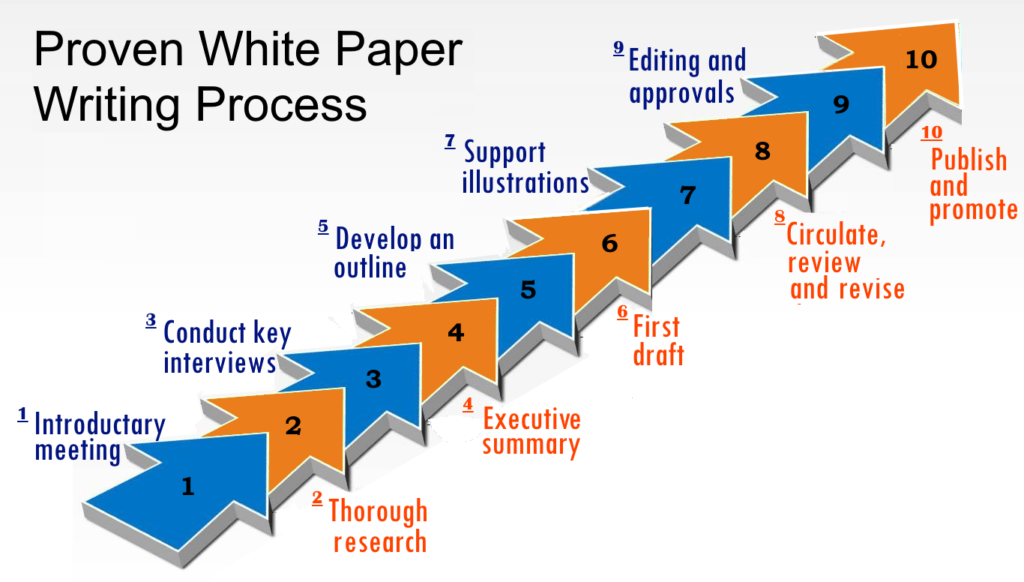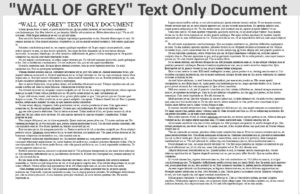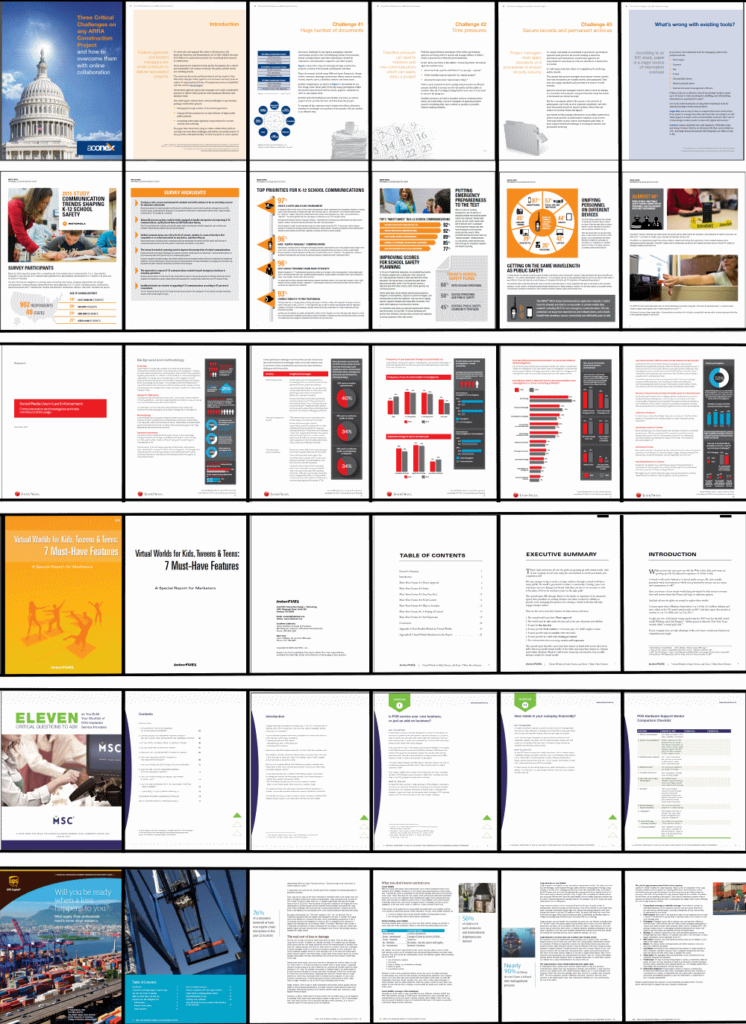AN OVERVIEW OF TODAY’S MODERN WHITE PAPER
Your Most Powerful Marketing Tool
One of the biggest challenges facing decision-makers is sorting through modern technologies that can help them achieve their mission. Cutting through the noise and establishing your firm as a leader needs a marketing tool that meets the needs of your prospects.
A white paper can be one of the most persuasive items in your marketing toolbox and one of the biggest returns on your investment. No other B2B marketing content establishes trust, generates leads, and moves prospects through the sales funnel as effectively as white papers.
But in reality, they are more than that. Historically, white papers began more than 100 years ago as government research reports. They took their roots in government policy and often set out proposals for legislative changes or the introduction of new laws. Back then and still today, white papers may advocate a change in methodology. They may also champion an organization's position or philosophy about a social or political issue, or another subject.
However, when it comes to B2B marketing, a white paper can be defined as a persuasive essay that uses facts and logic to introduce and promote a technology innovation, certain product, service or a solution to a problem.
These well-researched and factual reports are still a trusted format today. In fact, in a 2016 survey by the Content Marketing Institute, 71% of B2B marketers reported using white papers, up from 68% the year before.
White papers are
- Built from narrative text
- At least five pages long in portrait format
- Provide educational, practical, and useful content, not a sales pitch
- Provide well-researched facts, not just opinions
- Are used before a sale, not after a sale
- Include an introduction, abstract, or executive summary
 White Papers are white papers....except when they're not. Profound, isn't it?
White Papers are white papers....except when they're not. Profound, isn't it?
But maybe you know white papers as something else. Though there may be differences in definition and definitely in opinion of what these documents are called, you may have heard white papers referred to by any of these following terms. Some are accurate, while others...not so much.
If need help sorting through all these, give me a call and I'll help you clear it up or we'll work together to figure out what you need.- e-Book
- Case Study
- Persuasive Essay
- Rhetorical Analysis
- Competitive review
- Evaluator’s guide
- Buyer's Guide
- Comparative Analysis
- Executive briefing
- Issue Brief
- Data Sheet / Spec sheet
- Lead Magnet / Lead Generation Magnet
- Market overview
- Position paper / Position Statement
- Product briefing / Product Review
- Special report
- Conclusions Paper
- Technical Review, Guide
- Information Package
- Bait Piece
- Prospectus
- Resource List
- Gated Content
- Tutorial
- Report / Research Report
- User Manual
- Manifesto
Problem / Solution - Thought Leadership
The most powerful of all marketing white papers. Organize the white paper around a nagging industry problem that no one has ever properly solved, and the new, improved solution offered by your company.
Note: While this paper may provide a small amount of marketing content or a few features of your product near the end, a problem solution focuses primarily on the industry and not your company or product. It demonstrates that you are a thought leader in your industry. The final page or two may be about your company and briefly mentions your product that provides a solution...but the paper itself is is not about your company or product. However, once you are recognized as an industry thought leader, and can demonstrate that you have a solution, the reader is much more likely to engage with you.
Features-Benefits / BackgrounderOrganize the paper around a series of features and the concrete benefits each feature provides. It drills down in to a B2B offering. This is more useful for well-established leaders in their market, or at the end of the sales funnel.
This kind of paper is most useful at two points:
- To support the launch of a product or service
- To support an evaluation of competing offerings from different vendors
Enumerates a series of loosely connected ideas, facts, or arguments. It’s light and lively roundup of highlights about some issue. This is generally a much shorter paper, although it may be used in conjunction with either a problem/solution or features/benefit paper.
While the three main types of white papers listed above encompass most all types of white papers, white papers may also be sub-categorized into the below types. Contact me for more information.
- The One Pager
- Modular
- Chronological
- Physical
- Spatial
- Issues/Actions
- Opportunity/Leverage
- Form/Function
- Case study
- Argument/Fallacy
- Compare/Contrast
- Matrix
- Parallel Tracks
- Rhetorical Questions
According to Gordon Graham, the foremost expert on writing white papers, a white paper can present your best research and your most persuasive arguments in a compelling format that can be repurposed into many other forms of content.
Marketing Sherpa goes a step further in saying, "Probably the most important tool in the B2B marketer's kit is the white paper."
According to the findings from the 2015 Federal Media and Marketing Study, government decision-makers access information through an increasingly complex mixture of print, digital, mobile and social media. White papers and case studies lead the way for most trusted content at 41%.
That makes white papers the ideal marketing platform for any complex or expensive product aimed at public safety.
White papers build authority and demonstrate thought leadership papers in your industry, and they can be used to create or redefine a market space. Over 73% of IT buyers use white papers to investigate technology solutions.
Redefine a Market Space / Increase Market Share
White papers can help you stand out from competitor businesses and attract more customers than others by being innovative in your offers. Innovation is demonstrated in a white paper through a better solution than competitors in the space. This innovation and creates market demand, even when customers aren’t yet looking to fill a specific need.
Influence the Final Decisions Makers
White papers are the number one piece of marketing content that professionals turn to when making a buying decision; 77% of respondents read at least one white paper in the previous six months, and 84% of them rated white papers as moderately to extremely influential when making final purchasing decisions.10 This mirrors a 2016 survey that revealed 82% of B2B buyers relied on white papers to research their buying decisions.
Educate Prospects
Educating prospects with white papers is an effective tool in driving high-value leads. Yet this same marketing material can help to educate your own sales force or channel partners who may not fully understand the product and its benefits. More than 76% of IT buyers use white papers for education on a specific technology or issue.
Justify an Expensive Product
Law enforcement technology, by its very nature, can be expensive. A white paper has the ability be persuasive. A survey of IT managers showed that 42% of them read white papers to help justify buying decisions.
Improve the Sales Process
One survey reported that 72% of bad sales experiences result in a loss of revenue. When used as a guide or “leave behind,” white papers help improve the sales process, and close out sales. Pieterjan Bouten, co-founder and CEO of Showpad, stated, “Delivering the right content, in context, at the right time has proven to be critical to avoid a bad sales experience.”
Repurpose as Other Content
White papers have a longer shelf life and offer more possibilities to repurpose than any other content as articles, blogs, slide presentations, webinars, podcasts, infographics, press releases, videos, and social media posts. When properly optimized, they improve your SEO efforts and encourage inbound links.
Improve Lead Generation
White papers were ranked as “an excellent source of lead generation” by 74% of professional services companies,10 while white paper and eBook downloads were by far the top producers of leads, according to 59% of respondents.
Encourage Sharing
93% of IT buyers pass‐along up to half of the white papers they read,9 and 69% of prospects who like your white paper will pass it on to colleagues.15 In yet another survey, 89% of respondents responsible for making technology purchases passed white papers along to others.
- Well here are 29 options for you.
- Create an effective landing page on your website to use as a lead magnet
- Distribute via your sales & marketing channels
- Use it to educate your sales force on your product
- Have your sales reps use as a “Leave behind”
- E-mail it to channel partners (distributors, dealers, resellers)
- E-Mail, or Direct mail (FedEx stands out and will get opened) to key prospects
- E-Mail to current and past clients
- Distribute at trade shows, conferences, expos, seminars, conventions, speaking engagements, & training functions
- Send directly to your email list
- Send press release + white paper to bloggers and journalists for your space
- Submit it to whitepaper syndication sites, such as Bitpipe, Find Whitepapers, Tech Republic, Tech Target, and Knowledge Storm
- Share with relevant LinkedIn and Facebook groups
- Blog about the white paper
- Repurpose it as 2 or 3 blog posts
- Create a Facebook Page Tab for your whitepaper
- Submit a guest post about it to a popular industry blog
- Link to it at end of your blog posts
- Tweet it out in a Twitter series
- Update your social media page profiles with a link to your white paper landing page
- Link to it in your newsletter
- Create featured articles from it for LinkedIn Publisher, Medium, or other platforms
- Create featured articles from it for websites, magazines, & journals in your industry
- Submit to trade journals and websites
- Get it mentioned in your channel partner newsletters (if any)
- Repurpose into a webinar
- Repurpose a slide deck / PowerPoint & send to your sales force and channel partners
- Promote it with LinkedIn, Facebook and Twitter sponsored/promoted ads
- Promote it with a Google Ad campaign
- Talk about it on question/answer forums like Reddit, Quora
Many writers lack any process or skip over many of these essential steps. Without a disciplined process, a white paper can be thrown together without many of the necessary components. This is one reason so many white papers today suffer from so many common problem.
A poorly planned and executed white paper can fail to deliver the business results you hoped to see. Even worse, it can tarnish your credibility.
Proposal Stage: It starts with a simple, 15-minute conversation.
- Conduct a short phone conference to get the necessary details to complete a proposal for you.
- The proposal will include recommendations, ideas, best practices, pricing and timelines.
- At this stage, you haven't committed to anything, and we can revise our ideas.
- Client then completes the long form questionnaire followed by an initial kickoff conference call, preferably with all approving parties, to confirm the direction of the paper
- Conduct thorough research that backs up every claim made in the paper;
- Conduct key interviews with your experts, or from outside subject matter experts, as needed;
- Create a draft Executive Summary for clients review and comments to confirm we are heading in the right direction
- Create a detailed outline so you can quickly verify the approach is right on target;
- Craft a paper whose message is as powerful as its salesmanship is subtle;
- Use support illustrations, charts and graphs to let our facts stand out;
- Circulate, Review and Revise the paper until you are satisfied with it;
- Forward the final draft a professional editor.
- Complete a professional editorial print design to make your white paper pop and have an effective and lasting impression on the reader
- Deliver a final, polished copy alongside a complete PDF file of all sources, if requested, for your records.
- Publish, promote, and syndicate if applicable.

Working with a professional white paper writer can help you quickly take your white paper from idea to reality and turn your messages into compelling arguments.
WHAT TO LOOK FOR IN YOUR WHITE PAPER WRITER
Industry knowledge and technical competency
Does the writer understand your industry? Can they communicate complex concepts concisely?
Writers ask questions
They want to know as much as they can about the project so they can produce what you need.
Professionalism
Look for writers who maintain professional courtesy, communicate well, quickly respond to inquiries, and meet deadlines
Strong research skills
Ability to quickly find, analyze, and understand reputable information.
Excellent writing skills
This is the nuts and bolts of writing: grammar and spelling, choosing the proper tone, and getting the right words in the right places.
Persuasive and compelling
Different writers work differently and have different sensibilities. A writer should be capable of writing in a persuasive and compelling manner.
Interviewing ability
Can efficiently extract the key nuggets of information from experts.
SEO skills
A solid understanding of basic search engine optimization.
Writing voice
Should have a strong, confident writing voice that is clear, consistent, and easy to follow
Here are some stats to look at if you are considering trying to do it in-house or with an inadequate budget.
Among organizations whose content marketing success was more successful than one year ago, the number one factor that 85% of respondents attributed to their organization’s increase in overall success was higher quality, more efficient, “Content Creation.”
Among organizations whose content marketing success was less successful than one year ago, the number one factor that 52% of respondents attributed to their organization’s stagnancy was “Not Enough Time Devoted to Content Marketing.” The number two factor as given by 49% of respondents was “Content-Creation Challenges.”
Here are just a few top reasons to consider hiring a professional white paper writer:Benefit from Expertise
Professional white paper writers are adept at the latest tools and trends in writing and marketing and are well versed and up-to-date when it comes to essentials like SEO.
Achieve Better Results
Writing is a craft, and you benefit from the expertise of a skilled writer with an understanding of context, style, grammar, punctuation, and spelling.
Save Time
In-house content creation and development take time. A professional writer can leverage your engineers’ knowledge and your organizational goals by conducting interviews and weaving this information into a paper.
Benefit from outside objectivity
An outside writer is especially helpful in maintaining a sense of objectivity about your products or your company and can lend a fresh perspective that is sometimes better able to gauge your customers’ needs.
Achieve aggressive deadlines
Other important tasks often distract in-house writers. As part of their responsibility for delivering a superior product, professional writers must deliver on time.
With two decades in public safety and defense, including command experience, we have deep insight into public safety strategies, concepts, and processes. We recognize the industry challenges related to reforms, technology, and governance.
Proven process
Each project includes a comprehensive needs assessment, outline development, extensive interviews, a detailed review of your solution, research on your competitors and your industry, skillful writing, support illustrations, layout development, editorial review, and revisions.
High-performance results
We have many years of producing professional work content in a high-pressure environment with large work volumes and strict deadlines.
Skilled research
We bring decades of experience and training in investigations, field research, database usage, and deep internet research.
Extensive writing experience
With decades of influential writing experience including, white papers, blogging, and hundreds of reports with the intent of providing persuasive and compelling arguments.
Influential writing
With over two decades of influential writing experience, Jeremy has the core competencies to create compelling and persuasive white papers that establish thought leadership, generate leads, and accelerate sales.
Polished interview skills
Over two decades of experience interviewing for business, administrative and investigative purposes.
SEO and inbound marketing skills
Training and experience implementing SEO & Inbound Marketing techniques without creating “clunky” content.
Professional writing style
Focused, authoritative content that people connect with without all the fluff, jargon, or lengthy wording.
 Print layout design is a specialized skill, and can be time consuming or difficult to get it right. White papers need to have a natural attraction, be easy to read, easy to scan with your eyes, have the right amount of white space, proper fonts, graphs, charts, etc. A "wall of grey," that is a page of nothing but dark text on a light background is difficult to read, ineffective, and you will lose your audience quickly.
And while many clients also need print design layout, many others already have in-house editorial designers or a design template in place for their content including, white papers. If you need design layout, we offer it as an add-on service as well.
Here a just a few things involved in formatting your white paper:
Print layout design is a specialized skill, and can be time consuming or difficult to get it right. White papers need to have a natural attraction, be easy to read, easy to scan with your eyes, have the right amount of white space, proper fonts, graphs, charts, etc. A "wall of grey," that is a page of nothing but dark text on a light background is difficult to read, ineffective, and you will lose your audience quickly.
And while many clients also need print design layout, many others already have in-house editorial designers or a design template in place for their content including, white papers. If you need design layout, we offer it as an add-on service as well.
Here a just a few things involved in formatting your white paper:
- Cover page design
- Appropriate use of white space
- Text layout and positioning
- Font size, color, and type
- Formatting of headings & sub-headings
- Text and line spacing
- Proper bullet point and numbered list placement
- Content & Formatting of headers and footers
- Margins
- Proper indentation and spacing on paragraphs
- Tactically placed columns and tables
- Appropriate use of borders, shading, and background colors
- Frames, Text boxes, call-outs, and pull quotes
- Proper page breaks
- Graphics, images, charts and graphs
- ...and more

However, there can be an occasion for a white paper to be much longer.
Decision-makers do not have time to read through a rambling, imprecise, poorly-researched, and painfully-written white paper. They are not interested in straight sales copy.
One study among 1,400 business and IT executives across a range of industries indicated the following as the most common criticisms of white papers:19
- 53%: Hype and puffery of offerings
- 47%: Poor communication of business-value proposition
- 45%: Too few proof-points that show ROI of the solution
- 36%: Long-winded descriptions
- 48%: Expected a technology discussion, not product info
- 39%: Not-problem-solving focused
- 37%: Too product oriented
- 33%: Misleading Title
- Aggressive or overt sales pitch.
- Focuses on self-promotion rather than prospect’s needs.
- Does not understand and does not write for the audience.
- Does not educate; discusses a broad topic, not a problem.
- Lack of adequate research.
- Poorly written, bad grammar, spelling, and punctuation
- Impossible to skim due to poor design or typography.
- Lack of SEO/keyword optimization.
- Too long to be effective.
 Technology has advanced by leaps and bounds, changing the way safety forces everywhere do just about everything, and there is no slowing down. Sales of law enforcement equipment in the U.S. are expected to increase to $1.2 billion through 2020.
Technology has advanced by leaps and bounds, changing the way safety forces everywhere do just about everything, and there is no slowing down. Sales of law enforcement equipment in the U.S. are expected to increase to $1.2 billion through 2020.Technology acquisition and deployment decisions are highp riority topics for police, as law enforcement agencies at all levels of government spend vast sums on technology in the hopes of improving their efficiency and effectiveness.
This paper discusses the limitations of most traditional marketing approaches. It introduces an engaging, trusted, and effective marketing tool for public safety technology vendors: White Papers.
This White Paper is a solid sample of our writing that we think you’ll find useful for any industry. It’s also engaging and easy to read through, unlike the old boring white papers you may have experienced in the past.
Click HERE to download our FREE White Paper: ' How to Increase Sales to Public Safety Agencies Using White Papers.' No sign-up required to download.
Get connected
More Information
- (440) 278-4034
- Jeremy@jvec.me
